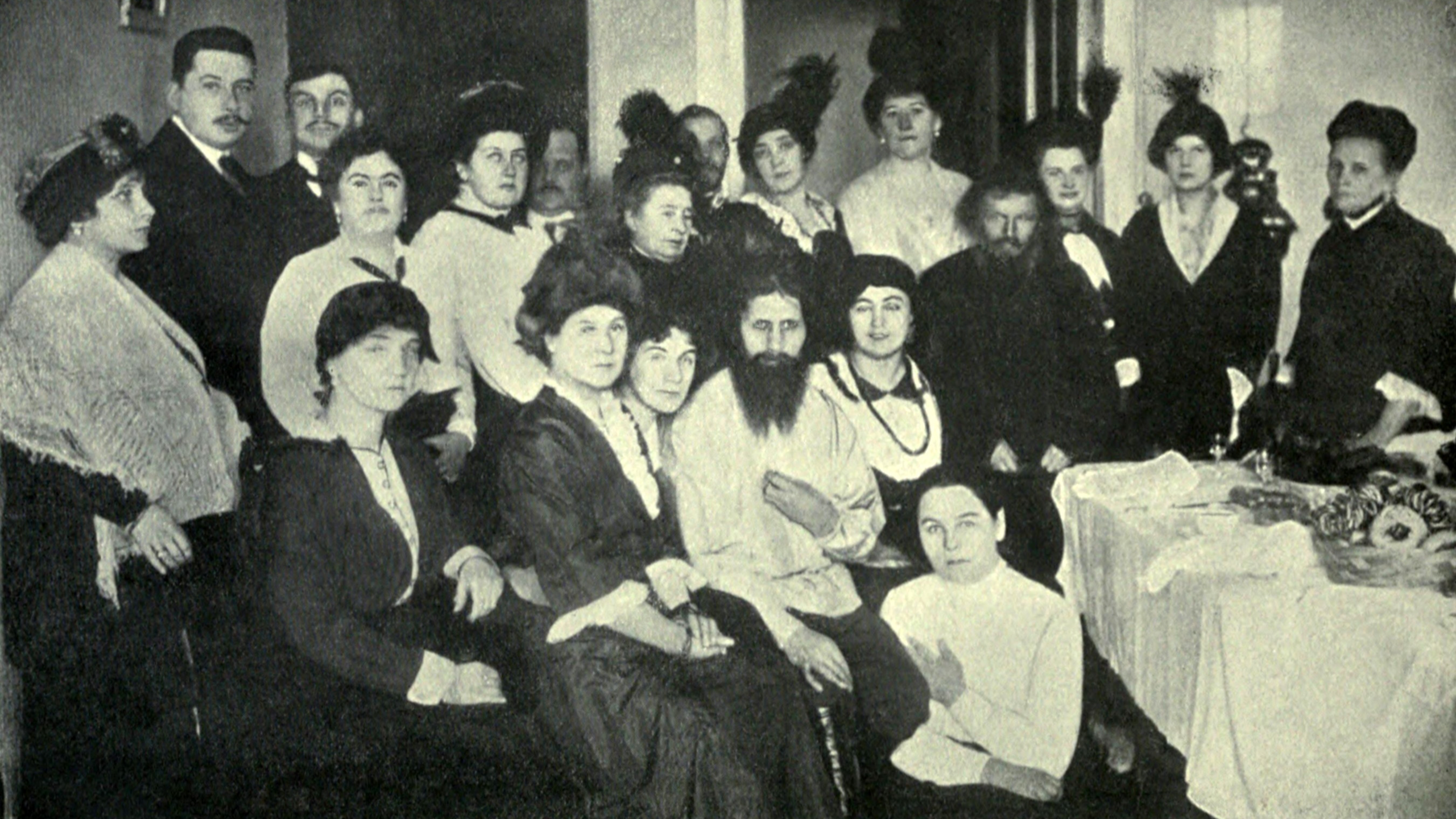The crazy life of "Gregory the Drunk" aka Rasputin
If you’re like me, you grew up watching the animated film Anastasia, about the long lost Grand Duchess Anastasia Nikolaevna Romanov of Russia. After I watched the movie, which was a fictional interpretation of the theories surrounding the youngest daughter of the Romanov family, I did my own research on the real story.

There grew my fascination with the story, theories, and all the people involved. It was through this story that I was first introduced to Rasputin. While the animated, fictionalized version of Rasputin was fantastically evil and the perfect animated villain, the real person was much more complex and lived an infamously intriguing life.
Rasputin (center) with admirers in 1914.

The life of Grigori Rasputin, for the most part, has been shrouded in mystery. Different sources have many different timelines for him and the events of his life. Because many facts of his life are unverified and contradicting, his legacy is full of mythology, mysticism, and a bigger than life type of presence. This has made him one of the more prominent figures to come out of the pre-Russian revolution era.
The legend begins
Grigori Rasputin was born in January, 1869 (conflicting documents say either January 10th or 21st) in the Siberian village of Pokrovskoye in Yarkovsky District, Tyumen Oblast, Russia. He was born to a peasant family, with an unknown amount of siblings, and while he did attend some school, he is thought to have remained illiterate for much of his life.
It has been thought that due to his horse stealing, promiscuousness and drunkenness, he was given the name “Rosputin,” which means “debauched or dissipated” in Russian.
A theory, from historian Joseph T. Fuhrmann, states the name may actually mean “where two rivers meet,” referring to an area close to where he was born in Siberia. Fuhrmann also believes that Grigori’s family was too poor to have a last name so he was dubbed Rosputin (which changed to Rasputin) by neighbors. Fuhrmann remarked how this could be casually interpreted as “Gregory the Drunk” or “Drunk Greg,” depending on the way and regional familiarity the phrase was used. Russian vocabulary implications are notoriously complex.
Already the subject of much gossip, he began claiming to have “mystic” abilities at an early age, and many people in his village believed he really did have powers.
From Siberia to the Winter Palace
At age 18 (some sources say 19), Rasputin married Proskovia Fyodorovna Dubrovina and had 3 children: Dmitry, Matryona (Maria), and Varvara. In 1897, he left family life and entered the monastery at Verkhoture, where he intended to become a monk. Here his next moves are questioned as historians have differing beliefs on what happened during this time. Facts about his family and early life are uncertain as Rasputin told many stories and it’s unknown which ones are true, if any.

Wax figure of Rasputin in the “How to kill Rasputin” exhibit. (Saint Petersburg, Russia, 2017)
One account, is that here he was introduced to Khlysty, a spiritual Christian sect that split from the Russian Orthodox Church. It is believed by some that he then took the teachings of Khlysty and twisted some of the teachings to fit his lifestyle.
One of the teachings he is thought to have most famously preached was the best way to be close to God was when feeling “holy passionlessness”—and the only way to reach this is through sexual exhaustion with both men and women. Though it is agreed that he did like to frequently drink and visit brothels, there is not much evidence that he was quite as “sex-crazed” as he was made out to be. Some believe these rumors may have been a way to propagandize his life by his enemies after the revolution.
The path to infamy
After leaving the Monastery, Rasputin wandered for some time. He traveled to Greece and Jerusalem, living off donations and becoming known as a “starets”– a self-proclaimed holy man and healer. In 1903, Rasputin traveled to St. Petersburg where he was welcomed by the church. As the church was just starting to explore mysticism and the occult, he fit right in.
In 1905, Rasputin was introduced to the royal family by church members, though not claiming Rasputin to be directly affiliated with the church. The hope being a “homely” holy man would appeal to the court and increase their importance to the Tsar and Tsarina.
Tsar Nicholas II and his wife Tsarina Alexandria were already heavily into healers and esoteric people, and had welcomed several into their court before. The royal family was comprised of the Tsar, Tsarina and their five children: Olga, Tatiana, Maria, Anastasia, and Alexei.
Their only son and heir to the throne, Alexei, was a hemophiliac. In 1908, Rasputin was called to the royal palace because their son was experiencing uncontrollable bleeding. After his session with the young boy, the bleeding seemed to slow down.
While the Tsarina was amazed by Rasputin’s healing “powers,” historians have hypothesized the bleeding slowing down was most likely due to Rasputin refusing to give aspirin to the boy, now known to be a blood thinner, and not any “powers.” Regardless, Alexandria enlisted Rasputin as the family’s healer and close adviser.

Rasputin (second from left) with admirers in 1911.
Rasputin quickly rose to fame as the royal’s holy man. At the time time, the imperial family’s popularity began to decline. Russia was already strained following the Russo-Japanese war and already gearing up for War World I with little time to recover. This conflict would be the first time in modern era where a European nation would be defeated by an Asian power. Many Russians found Nicholas II’s leadership during the war with Japan to be ineffective, and didn’t have much faith in his abilities going into World War I.
The Mad Monk
Rasputin had gained many followers by this point, most being women, and many of those being women of the court. He was seen as a powerful healer which garnered many admirers and gave him great influence. Regardless of what was true, Rasputin was seen as a threat to the Russian empire and thought to have too much authority in and outside the royal family.
These grumblings started early, and grew malcontent over the years. In 1914, a peasant woman stabbed Rasputin, but he eventually recovered. This began a paranoia that lead Rasputin to act even more erratically.
Missteps of the Tsar
With World War 1 going poorly, the situation became dire. In 1915, Tsar Nicholas II left St. Petersburg to take control of the failing Russian Army front. By 1917, corruption in the government was running rife and the economy was severely damaged by the strains of war. Moderates began to join the radical Bolshevik revolutionaries calling for the removal of the royal family.
With the Tsar on the front lines, Alexandria was left to take care of domestic responsibilities at home alone. It was rumored that Rasputin took this opportunity to impose his influence on the Tsarina.
Rumors kill
While it is agreed by many historians that Rasputin did give military advice and did appoint his own church ministers and other public officials, often inept opportunists, he did not have as great of an influence on the Tsarina’s rulings as people perpetuated.
Another rumor spread was that Rasputin and Alexandria were lovers. This has been disputed by most historians as complete fiction, perhaps to discredit and humiliate the Tsarina. Since she always defended Rasputin whenever confronted with stories of his promiscuousness and debauched lifestyle, this further exasperated these rumors.
The last huzzah
On the night of December 30th, 1916, Rasputin was invited to the home of Prince Felix Felixovich Yusupov (husband of the Tsar’s niece) home along with Vladimir Mitrofanovich Purishkevich (a member of Duma), and Grand Duke Dmitry Pavlovich (the Tsar’s cousin).
According to Oxford, Felix claims he gave Rasputin poisoned wine and tea cakes.
As legend has it, when Rasputin did not immediately die, a panicked Felix shot Rasputin at close range. Still alive, Rasputin was able to run into the courtyard. This is where Purishkevich shot him again. They bound the wounded monk, and threw him into a hole in the ice of the Neva River. This being where he finally died from drowning.
This is the story that is largely reported when talking about Rasputin’s death. This story about being so hard to kill helped create one of the many mysterious aspects of Rasputin and helped catapult him into a historical legend.

Rasputin’s grave site. Saint Petersburg, Russia
Though it is an impressive story, it has been challenged by some historians. The initial autopsy did not mention poison in Rasputin’s system. However, a 1934 report suggested the cyanide that was allegedly used may have been from a bad stock or had expired. As a result, the potency may have been drastically reduced.
This combined with rumors that a paranoid Rasputin had been exposing himself to small amounts of potions to build immunity may have also been a factor.
Other theories suggest the cake may have actually saved Rasputin. Studies have shown certain carbohydrates bind to cyanide. Thus, potentially reducing the effectiveness of the poisoned cakes.
Slightly more probably is the theory that Rasputin had alcoholic gastritis. This would have hindered the conversion process of turning potassium cyanide into hydrogen cyanide, and reduced the likelihood of the substance acting as intended.
A night shrouded in mystery
Purishkevich’s account has changed over the years. So, some believe there may not have been any poison at all.
Nevertheless, most historians believe Rasputin died from a gunshot wound to the head. Furthermore, that he was already dead when he was thrown into the river. This does not discount the documentation of brain synapses firing after death. Consequently, the assailants may have believed Rasputin was not truly dead when they threw him in the river.

Prince Felix Yusupov (left) and Grigori Rasputin (right)
Rasputin’s killer, Felix Felixovich Yusupov (1887-1967) stated he believed the murder was necessary to save Russia. However, it was too little too late. He would soon escape to France, with his family, after the fall of the Russian monarchy. Purishkevich would participate in the Russian civil war, but would die of typhus in 1920.
Fall of the Tsar
On March 15, 1917, Tsar Nicholas II relinquished the throne as a result of the Russian Revolution. Though Rasputin was dead by this point, the myths of his life, influence, and death endured. Many historians agree that Rasputin’s influence did play a role in the disdain for the royal family.
Rasputin’s presence at the royal court made Russia question the royal family’s authority and decision making, as many people felt Rasputin was a leech and manipulating the Tsar and his wife. This distrust in the royal family played a major role in the Revolution.
Rasputin: Legacy after death
Grigori Rasputin is a mythical person, indeed. He was many things to many different people. He’s someone who lived seemingly balancing two halves of his life that completely contradicted each other, constantly calling into question, who is Grigori Rasputin really? The debauched, ruffian, sex deviant who manipulated the royal family? Or is he the holy man who truly wanted to help and heal others? Unfortunately, because most of his life is seated firmly in rumors and speculation, there’s really no way for us to know who he truly was.
One thing that adds to the legend, Rasputin wrote a letter to Tsar Nicholas II that may have “predicted” the future. He claimed he suspected he may soon be murdered. Also, if it was done by nobles, it would bring down the monarchy.
















Conversation